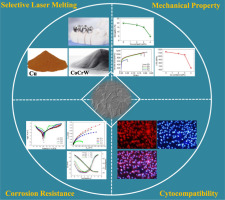Journal of the Mechanical Behavior of Biomedical Materials ( IF 3.9 ) Pub Date : 2018-02-23 , DOI: 10.1016/j.jmbbm.2018.02.026 Yanjin Lu , Ling Ren , Xiongcheng Xu , Yang Yang , Songquan Wu , Jiasi Luo , Mingyu Yang , Lingling Liu , Danhong Zhuang , Ke Yang , Jinxin Lin

|
In the study, CoCrWCu alloys with differing Cu content (2, 3, 4 wt%) were prepared by selective laser melting using mixture powders consisting of CoCrW and Cu, aiming at investigating the effect of Cu on the microstructures, mechanical properties, corrosion behavior and cytotoxicity. The SEM observations indicated that the Cu content up to 3 wt% caused the Si-rich precipitates to segregate along grain boundaries and in the grains, and EBSD analysis suggested that the Cu addition decreased the recrystallization degree and increased the grain diameter and fraction of big grains. The tensile tests found that the increasing Cu content led to a decrease of mechanical properties compared with Cu-free CoCrW alloy. The electrochemical tests revealed that the addition of Cu shifted the corrosion potential toward nobler positive, but increased the corrosion current density. Also, a more protective passive film was formed when 2 wt% Cu content was added, but the higher Cu content up to 3 wt% was detrimental to the corrosion resistance. It was noted that there was no cytotoxicity for Cu-bearing CoCrW alloys to MG-63 cell and the cells could spread well on the surfaces of studied alloys. Meanwhile, the Cu-bearing CoCrW alloy exhibited an excellent antibacterial performance against E.coli when Cu content was up to 3 wt%. It is suggested that the feasible fabrication of Cu-bearing CoCrW alloy by SLM using mixed CoCrW and Cu powders is a promising candidate for use in antibacterial oral repair products. This current study also can aid in the further design of antibacterial Cu-containing CoCrW alloying powders.
中文翻译:

铜对选择性激光熔炼CoCrW合金组织,力学性能,耐蚀性和细胞毒性的影响
在研究中,使用由CoCrW和Cu组成的混合粉末通过选择性激光熔化制备了具有不同Cu含量(2、3、4 wt%)的CoCrWCu合金,旨在研究Cu对微观组织,力学性能,腐蚀行为的影响。和细胞毒性。SEM观察表明,高达3 wt%的Cu含量导致富Si析出物沿晶界和晶粒偏析,并且EBSD分析表明,添加Cu会降低重结晶度并增加晶粒直径和大晶粒度。谷物。拉伸试验发现,与无铜CoCrW合金相比,增加的Cu含量导致机械性能下降。电化学测试表明,铜的添加将腐蚀电位移向了更高的正电位,但增加了腐蚀电流密度。另外,当添加2wt%的Cu含量时,形成了更具保护性的钝化膜,但是高达3wt%的较高的Cu含量不利于耐腐蚀性。值得注意的是,含铜的CoCrW合金对MG-63细胞没有细胞毒性,并且细胞可以很好地散布在所研究的合金表面。同时,当Cu含量高达3wt%时,含Cu的CoCrW合金表现出对大肠杆菌的优异的抗菌性能。有人提出,使用混合CoCrW和Cu粉末通过SLM可行地制造含CuCoCrW合金是在抗菌口腔修复产品中使用的有希望的候选者。这项当前的研究还可以帮助进一步设计抗菌的含Cu CoCrW合金粉末。当添加2wt%的Cu含量时,形成了更具保护性的钝化膜,但是高达3wt%的较高的Cu含量不利于耐腐蚀性。值得注意的是,含铜的CoCrW合金对MG-63细胞没有细胞毒性,并且细胞可以很好地散布在所研究的合金表面。同时,当Cu含量高达3wt%时,含Cu的CoCrW合金表现出对大肠杆菌的优异的抗菌性能。有人提出,使用混合CoCrW和Cu粉末通过SLM可行地制造含CuCoCrW合金是在抗菌口腔修复产品中使用的有希望的候选者。这项当前的研究还可以帮助进一步设计抗菌的含Cu CoCrW合金粉末。当添加2wt%的Cu含量时,形成了更具保护性的钝化膜,但是高达3wt%的较高的Cu含量不利于耐腐蚀性。值得注意的是,含铜的CoCrW合金对MG-63细胞没有细胞毒性,并且细胞可以很好地散布在所研究的合金表面。同时,当Cu含量高达3wt%时,含Cu的CoCrW合金表现出对大肠杆菌的优异的抗菌性能。有人提出,使用混合CoCrW和Cu粉末通过SLM可行地制造含CuCoCrW合金是在抗菌口腔修复产品中使用的有希望的候选者。这项当前的研究还可以帮助进一步设计抗菌的含Cu CoCrW合金粉末。值得注意的是,含铜的CoCrW合金对MG-63细胞没有细胞毒性,并且细胞可以很好地散布在所研究的合金表面。同时,当Cu含量高达3wt%时,含Cu的CoCrW合金表现出对大肠杆菌的优异的抗菌性能。有人提出,使用混合CoCrW和Cu粉末通过SLM可行地制造含CuCoCrW合金是在抗菌口腔修复产品中使用的有希望的候选者。这项当前的研究还可以帮助进一步设计抗菌的含Cu CoCrW合金粉末。值得注意的是,含铜的CoCrW合金对MG-63细胞没有细胞毒性,并且细胞可以很好地散布在所研究的合金表面。同时,当Cu含量高达3wt%时,含Cu的CoCrW合金表现出对大肠杆菌的优异的抗菌性能。有人提出,使用混合CoCrW和Cu粉末通过SLM可行地制造含CuCoCrW合金是在抗菌口腔修复产品中使用的有希望的候选者。这项当前的研究还可以帮助进一步设计抗菌的含Cu CoCrW合金粉末。有人提出,使用混合CoCrW和Cu粉末通过SLM可行地制造含CuCoCrW合金是在抗菌口腔修复产品中使用的有希望的候选者。这项当前的研究还可以帮助进一步设计抗菌的含Cu CoCrW合金粉末。有人提出,使用混合CoCrW和Cu粉末通过SLM可行地制造含CuCoCrW合金是在抗菌口腔修复产品中使用的有希望的候选者。这项当前的研究还可以帮助进一步设计抗菌的含Cu CoCrW合金粉末。


























 京公网安备 11010802027423号
京公网安备 11010802027423号